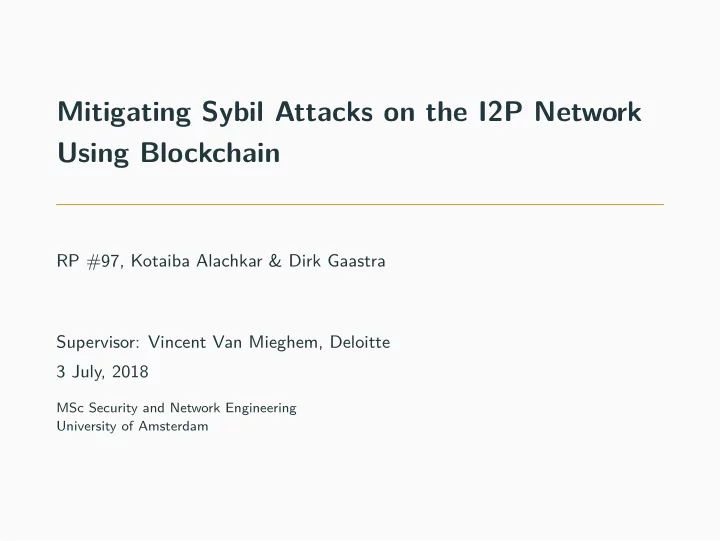

Mitigating Sybil Attacks on the I2P Network Using Blockchain RP #97, Kotaiba Alachkar & Dirk Gaastra Supervisor: Vincent Van Mieghem, Deloitte 3 July, 2018 MSc Security and Network Engineering University of Amsterdam
Introduction
I2P - Invisible Internet Project Anonymous Communication Network (ACN), similar to TOR, but with a few differences. • Fully peer-to-peer • No exit nodes • Internal communication only • Designed for slightly different purposes (e.g. filesharing) • Garlic routing • Unidirectional tunnels 1
Network Topology Figure 1: I2P network topology example 1 1 https://geti2p.net/_static/images/net.png 2
netDb - Network DataBase • Used for looking up resources: RouterInfos and LeaseSets • Distributed across so-called FloodFill routers • Automatically selected based on performance (e.g. bandwidth) • Or manually enabled • Each FF router is responsible for a part of the network • Based on Kademlia-style metric to determine closeness • Hash of RouterIdentity + current date • Changes every day at midnight (UTC) • aka ”keyspace rotation” 3
I2P - User-base Figure 2: Rough estimation of the average number of I2P nodes 4
Sybil Attack Figure 3: Sybil by F. R. Schreiber 2 ”A case study of a woman diagnosed with dissociative identity disorder 3 ” 2 http://whenfallsthecoliseum.com/wp-content/uploads/sybil.jpg 3 https://en.wikipedia.org/wiki/Sybil_(Schreiber_book) 5
Sybil Attacks Create a large number of pseudonymous identities in order to cripple the peer-to-peer system Its impact depends on: • how cheaply identities can be generated • accept inputs from untrusted entities • whether all entities treated identically 6
Sybil Attack on I2P Figure 4: Partial keyspace Sybil attack example Attack is very feasible, even with limited resources [1] 7
Research Question How can a Sybil attack on the I2P network be made infeasible? 8
Methodology
Methodology • Evaluate existing mitigation state on the network • Examine proposed solutions from previous research • Construct our own solution 9
Evaluation
Current State • Router election • Enough resources required to be considered • Currently, becoming FF router is not hard • Keyspace rotation • Router ID hashed with date to determine closeness • Possible to precompute identities • Blacklist • Block known bad IPs • Centralized (blogs, forums, etc.) • Quis custodiet ipsos custodes? 10
Previous Research
Previous Research: PoW Proof-of-Work (PoW) suggested by I2P contributors [2] • Using HashCash 4 • Finish PoW before creating router • However, • Difficulty of PoW hard to determine • Trivial for a reasonably powerful attacker 4 http://www.hashcash.org/ 11
Previous Research: Reputation Age-based reputation suggested by Egger et al. [1] • The longer a router is active, the higher the reputation • Bootstrapping issue • New router has no age information on peers 12
Our Contribution
Goal • Make it harder to create successful Sybil nodes • Create tamper-proof platform • Traceability • Evaluate FF routers • Offer both preventative, proactive, and retroactive solutions 13
Criteria Our solution should be: • Distributed • Public • Permissionless • Anonymous • Open-source 14
Distributed ledger technologies - why blockchain Distributed ledger - decentralized database which is synced and consented upon by all participants of the network Figure 5: DLTs comparison summary 15
Distributed ledger technologies - why blockchain Distributed ledger - decentralized database which is synced and consented upon by all participants of the network Figure 6: DLTs comparison summary 16
Implementation
General Concept • Keeping track of FF routers • Verify age • Determine trustworthiness of FF router • Use blockchain randomness for closeness metric 17
Implementation • Proof-of-Work vs Proof-of-Stake • PoW: High computation power required to add block • PoS: nodes with more coins have a higher chance to add a block • Incentive for miners • Reputation • Nodes should make decisions individually • Who to trust? • Who not to trust? 18
Proof-of-Stake • Miner chosen based on their wealth • Wealthier miners have a higher stake and are more likely to be trustworthy • No expensive hardware required • Virtually all nodes are able to join • More decentralized than PoW • In PoW, miners tend to pool together 19
Individual Decisions Being able to make decision about trustworthiness of a router is important... • Be as decentralized as possible • Nodes can come up with own criteria • Strict criteria for the paranoid • Loose criteria for performance-minded 20
Transaction types MinerTransaction Reward for the miner EnrollmentTransaction Enrollment as miner RouterUp Announcement of new FF router RouterDown FF router no longer responsive Table 1: Blockchain transactions [3] 21
General Structure • First block should have all FF routers • Subsequent blocks update that list • Traverse chain to get router age Figure 7: Overview of blockchain 22
Positive Externalities More advantages to blockchain... • Bootstrapping issue solved • Nonce provides non-deterministic hash for router closeness • Retroactively and proactively verify attacks • Check certain criteria • Individually verify attack likelihood 23
Conclusion
Conclusion A Sybil attack can be made less feasible by using blockchain • The age and reputation of Floodfill routers can be identified • Routers are able to build up reputation • FF routers need reputation before they can join • The Kademlia closeness metric can be made non-deterministic 24
Future Work
Future Work • Study privacy implications • Implementational details • Exact Proof-of-Stake algorithm used • Analysis of the network’s performance with blockchain • Practical analysis of other technologies • Explore other solutions blockchain could provide to I2P • Replace netDb • Provide payment platform 25
Q&A Figure 8: Presentation Overview 26
References Christoph Egger, Johannes Schlumberger, Christopher Kruegel, and Giovanni Vigna. Practical attacks against the i2p network. In International Workshop on Recent Advances in Intrusion Detection , pages 432–451. Springer, 2013. I2p’s threat model, 2010. https://geti2p.net/en/docs/how/threat-model. Neo white paper, Nov 2016. http://docs.neo.org/en-us/. 27
Miner Incentive • Altruistic nodes • Could work for I2P. However... • Blockchain reliability should not lean on this • Monetary • Advantage: currency for users • Disadvantage: complicated blockchain construction • Reputation • Two birds, one stone • Incentive and measure of trustworthiness 28
Recommend
More recommend